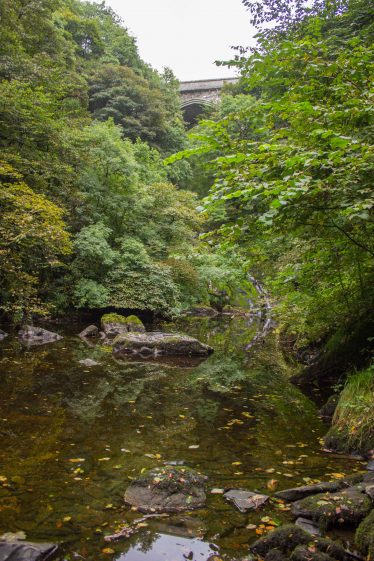Poulaphouca Bridge


After it emerges from Blessington Lake, the River Liffey passes under the busy N81 road, leaves County Wicklow and enters County Kildare. Before the construction of the dam in the 1940s this was the site of a spectacular waterfall known as Pollaphuca. The name Pollaphuca means the goblin’s hole or pit. In the early 19th century, when the area was being mapped by the Ordnance Survey, the surveyors recorded that “when the river is swollen by heavy rains the water rushes down with tumultuous impetuosity into a circular basin of the rock worn quite smooth and of great depth. From this the fall takes it name”. Pollaphuca is also documented in the Civil Survey of the mid 1600s and the name was said to be of native Irish origin. It may well be that the tale of a goblin or pooka residing at the falls served to keep children and other curious individuals away from the dangerous cascade.
Several sketches and drawings from the late 18th and early 19th centuries, four of which are held in the National Library of Ireland, attest to the majestic nature of the waterfall. It plunged down through the gorge in three separate cascades and must have formed a dramatic scene. Pollaphuca became a popular beauty spot in the 19th century, especially following the construction of the Blessington & Pollaphuca rail line, which provided a convenient connection to Blessington and on to Dublin. A hotel near the base of the falls was the hub of this new tourist industry.
In the 1820s construction of a bridge to span the river gorge commenced. The architect was Alexander Nimmo, a Scottish engineer who spent much of his career in Ireland, where he was involved in several public works projects. He is perhaps most associated with the western seaboard, where he oversaw the construction of many harbours and piers, but the bridge at Pollaphuca is testament to his skill. It is a single span bridge, embedded into the rock at either side, with a pointed and decorated arch. There are four distinctive castellated parapets on both ends of the bridge at either side which project above the bridge to form crenellated refuges.
The bridge is probably best appreciated from the grounds of the nearby hotel, subject to permission from the owners. The waters of the Liffey no longer thunder down the rocks at they once did. These days the flow is regulated by the dam and hydro-electric plant upstream.
Just 100 metres south of the Pollaphuca Bridge is another feat of 19th century engineering. The so-called Dry Bridge spans a wide and deep gorge which unusually has no river at its base. It is though that the course of the River Liffey once flowed through here but that is cut a new channel to the north which led to the gorge becoming dry.




No Comments
Add a comment about this page